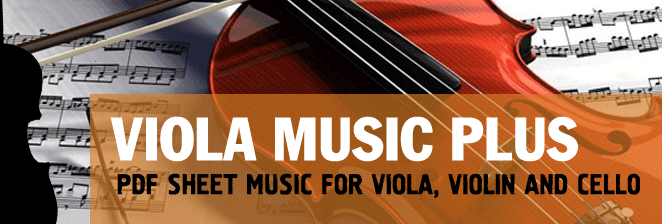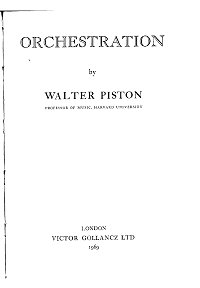|
|
 |
|
| |
| |
|
Walter Piston - Orchestration (1969) |
Piston Walter - Orchestration (1969)
Piston Walter - Orchestration (1969). You can download the PDF sheet music Piston Walter - Orchestration (1969) on this page. Throughout the book emphasis is placed on the method of study, the orientation of the student's program of action, to help him in continuing further studies along the paths suggested. The material covered is designed for a year's course in orchestration at the college level, but it is the author's conviction that the subject matter is too flexible to be presented as a course of graduated steps and exercises. A presentation is called for that will be adaptable to varied musical backgrounds, although it will always be difficult for persons lacking a knowledge of harmony and counterpoint to work out problems in orchestration. The student should be stimulated to make acquaintance with scores, and to develop self-reliance and initiative in seeking a deep knowledge of the instruments and how they are combined. Such a presentation will be found, it is hoped, in this introduction to the art of orchestration.
To download PDF, click the "Download PDF" button below the appropriate sheet music image.
To view the first page of Piston Walter - Orchestration (1969) click the music sheet image. |
| PDF format |
|
|
|
Book: 484 pages. 138605 K
|
|
 |
|
|
|
| Download PDF (14.99
€) |
|
|
|
Orchestration, in the sense here employed, refers to the process of writing music for the orchestra, using principles of instrumental combination essentially those observed operating in the scores of Haydn, Mozart, and Beethoven. It is a common technique, employed in present-day symphonic music as well as in that of the classical and romantic periods. For the present purposes it will not be considered to embrace earlier processes based on improvisation, fortuitous instrumental balance, and the stabilizing influence of a keyboard instrument, with basso continuo.
The true art of orchestration is inseparable from the creative act of composing music. The sounds made by the orchestra are the ultimate external manifestation of musical ideas germinated in the mind of the composer. One skilled in the technique of orchestration may practice a somewhat lesser art of transcribing for orchestra music originally written for another medium. This can be a fine though difficult art, provided the orchestrator is able to put himself momentarily in the composer's place, and, so to speak, to think the composer's thoughts. Failing this, the result is unlikely to amount to more than a display of skill and craft, often of a superficial and artificial nature.
The technical equipment of both composer and orchestrator must include a thorough knowledge of the individual instruments, their capabilities and characteristics, and a mental conception of the sound of each. Then the effects and resources of instrumental combination must be learned, involving such matters as balance of tone, mixed tone colors, clarity in texture, and the like. Finally, the orchestra is to be sensed as itself an individual instrument, flexibly employed to present the music, in form and content, with fidelity and effectiveness.
A multitude of obstacles and unsolved problems has prevented the establishment of a science of orchestration. The imperfection and vagueness of our musical notation makes it impossible to indicate with accuracy dynamic and rhythmic quantities as well as pitch, to say nothing of shades of tone color, warmth and intensity. One consequence of this is the preponderance of the role played by the performers and the conductor in the translation of written notes into sound. It is a well-known fact that no two performances of a work sound alike, and we find pleasure and satisfaction in this versatility of music as written. But for the student anxious to know the effect in sound of what he has put on paper, the unknown quantity of the performer's understanding has to be acknowledged in his calculations.
There are also mechanical and physical influences that cause variants in the sound of an orchestral score. No two orchestras sound alike. They may differ in the number of strings, in the quality and make of the instruments, and quite naturally in the capabilities of the players. A wide difference exists in the acoustic properties of the various auditoriums in which the individual orchestras habitually play, and the same orchestra will sound different in a different place.
Because of this variety in the sounds produced from the same given notes, and also because the student of orchestration seldom has an opportunity to hear those notes played at all, the student works under severe handicaps in striving to cultivate a capacity for the mental hearing of orchestral scores. In the event that his opportunities are limited to hearing phonograph records and radio broadcasts, he must be cautioned that these resources often have serious and misleading deficiencies. It is possible to doubt that the usual commercial recording of a symphonic work can stand the test of comparison with the printed score. At least in this writer's experience, almost every recording produces some sounds that do not exist in the score, and fails to produce some of the notes printed therein, besides showing numerous other discrepancies. The phonograph record is valuable as a means of conveying the over-all effect of a composition, but it is an insecure medium through which to store up instrumental sounds in the memory, or to ascertain the sound effect of a printed page of orchestration. |
|
|
|
|
| |
|
|
| |
|
|
|
|